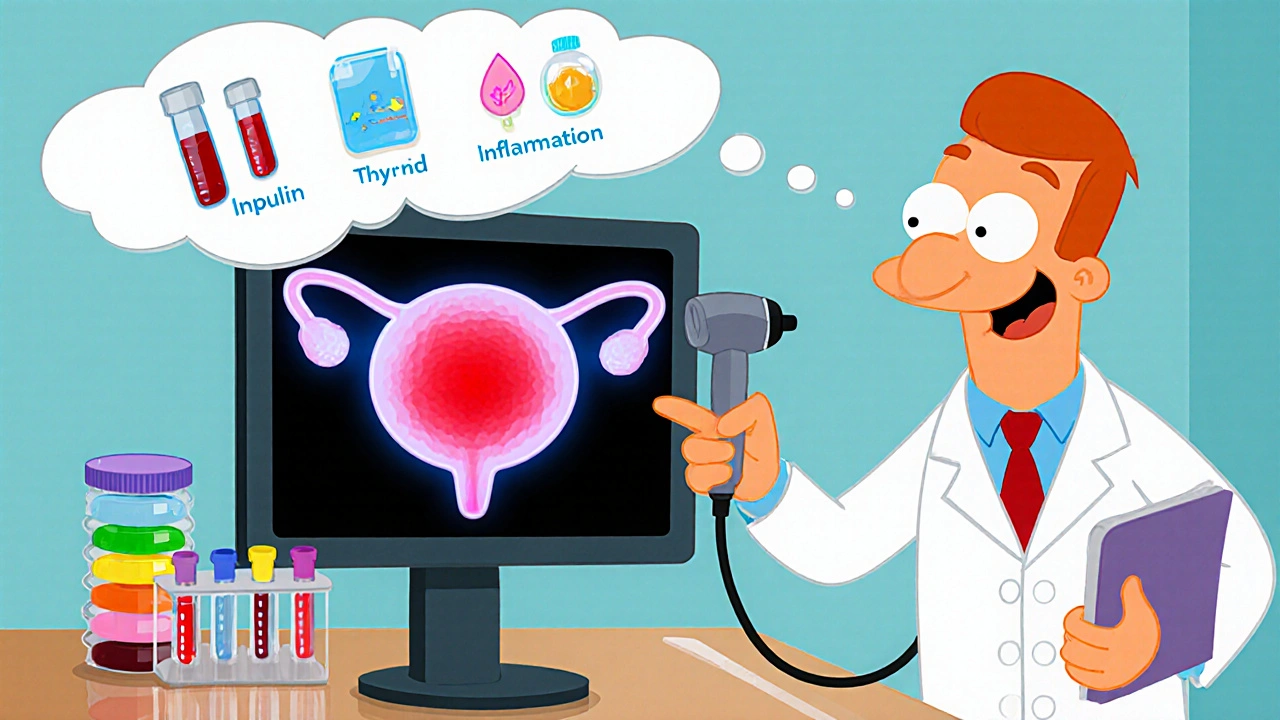Quick Takeaways
- Endometrial hyperplasia is often driven by excess estrogen and low progesterone.
- Hormonal imbalance can disrupt energy metabolism, leading to chronic fatigue.
- Common culprits include insulin resistance, thyroid dysfunction, and chronic inflammation.
- Accurate diagnosis combines pelvic ultrasound, endometrial biopsy, and blood hormone panels.
- Lifestyle tweaks, targeted supplements, and, when needed, hormone therapy can break the fatigue cycle.
What Is Endometrial Hyperplasia?
When doctors talk about Endometrial hyperplasia is a condition where the lining of the uterus grows excessively thick, often driven by hormonal imbalance. The endometrium normally thickens each month to prepare for a possible pregnancy, then sheds during menstruation. In hyperplasia, estrogen pushes the lining to keep thickening while progesterone fails to signal a proper shed, creating a cycle of over‑growth.
There are several sub‑types, ranging from simple hyperplasia with no atypia (low cancer risk) to complex atypical hyperplasia (higher risk of progressing to endometrial cancer). The key takeaway is that the uterus becomes a hormone‑sensitive over‑growth machine.
Understanding Chronic Fatigue Syndrome
Chronic fatigue syndrome (also called Myalgic Encephalomyelitis) is a multi‑system disorder marked by debilitating, unexplained fatigue that doesn’t improve with rest. It often co‑exists with brain fog, unrefreshing sleep, and orthostatic intolerance. While the exact cause remains unknown, research points to immune dysregulation, mitochondrial dysfunction, and endocrine disturbances.
People with CFS report a daily "energy ceiling"-a point after which any activity triggers a crash lasting days. This makes it hard to identify a single trigger, but hormonal fluctuations are a common denominator.
How Hormonal Imbalance Links the Two
Both conditions share a common hormonal thread. Estrogen is a hormone that promotes cell growth in many tissues, including the uterine lining. When estrogen levels stay high or progesterone stays low, the endometrium doesn’t shed properly, leading to uterine lining overgrowth. At the same time, estrogen interacts with the brain’s energy‑regulating pathways. Excess estrogen can raise cortisol, the stress hormone, which taxes the mitochondria and fuels a feeling of constant exhaustion.
Progesterone counteracts estrogen’s proliferative effects and helps stabilize mood and sleep. A deficiency-common in conditions like Polycystic Ovary Syndrome (PCOS) or perimenopause-means the uterus stays in a growth mode and the brain’s energy balance stays off‑kilter.

Common Underlying Factors
Several health issues act as hidden bridges between endometrial hyperplasia and chronic fatigue:
- Insulin resistance: Insulin resistance raises circulating insulin, which in turn stimulates ovarian estrogen production. High insulin also drains cellular energy, worsening fatigue.
- Thyroid dysfunction: Thyroid dysfunction, especially hypothyroidism, slows metabolism, hampers hormone clearance, and creates a perpetual low‑energy state.
- Chronic inflammation: Elevated cytokines (IL‑6, TNF‑α) interfere with the hypothalamic‑pituitary‑adrenal (HPA) axis, disrupting both menstrual regulation and energy production.
- Vitamin D deficiency: Low vitamin D is linked to both abnormal uterine lining growth and immune‑mediated fatigue.
- Stress and cortisol: Persistent stress spikes cortisol, which can blunt progesterone synthesis and degrade mitochondrial function.
Diagnostic Steps
Getting to the root of the problem means a layered approach:
- Medical history and symptom diary: Track menstrual patterns, fatigue spikes, sleep quality, and diet.
- Pelvic ultrasound: Visualizes endometrial thickness. Anything over 12 mm in the proliferative phase signals hyperplasia risk.
- Endometrial biopsy: Endometrial biopsy provides tissue for microscopic analysis, confirming simple or atypical hyperplasia.
- Hormone panel: Measures estradiol, progesterone, LH/FSH, thyroid (TSH, Free T4), fasting insulin, and cortisol.
- Metabolic tests: HbA1c and lipid profile assess insulin resistance and cardiovascular risk.
- Immune markers: CRP, ESR, and cytokine panels help rule in chronic inflammation.
Putting the results together creates a picture of whether hormonal excess, metabolic dysfunction, or an immune trigger is driving both the uterine overgrowth and the fatigue.
Management Strategies
Therapy targets three fronts: hormonal balance, metabolic health, and energy restoration.
1. Hormone‑Focused Interventions
- Progesterone therapy: Cyclical oral micronized progesterone (200‑300 mg nightly) restores the natural estrogen‑progesterone rhythm and often shrinks the endometrium within 3-6 months.
- Selective estrogen receptor modulators (SERMs): For women who cannot take progesterone, agents like raloxifene can block estrogen’s proliferative action on the uterus.
- Birth control pills: Combined oral contraceptives (COCs) provide steady progesterone, reducing hyperplasia risk and often improving fatigue by stabilizing hormone swings.
2. Metabolic Corrections
- Low‑glycemic diet: Emphasize whole grains, legumes, and plenty of non‑starchy veg to lower insulin spikes.
- Targeted supplements: Inositol (2 g twice daily) improves insulin sensitivity; magnesium (300 mg) supports mitochondrial ATP production.
- Regular movement: Light‑to‑moderate cardio (walking, cycling) 30 min most days reduces insulin resistance and boosts energy.
3. Restoring Energy Pathways
- Coenzyme Q10: 100 mg daily helps mitochondria generate more ATP, easing brain fog.
- Vitamin D3: 2,000-4,000 IU daily to reach serum levels >30 ng/mL.
- Sleep hygiene: Dark, cool bedroom, consistent bedtime, and limited caffeine after 2 pm improve restorative sleep.

When to Seek Professional Help
If you notice any of the following, book an appointment promptly:
- Endometrial thickness >12 mm on ultrasound.
- Persistent pelvic pain, abnormal bleeding, or spotting between periods.
- Fatigue that worsens despite sleep, diet, and stress management.
- Weight gain, especially around the abdomen, coupled with sugar cravings.
- Family history of endometrial or ovarian cancer.
Early detection of atypical hyperplasia can prevent progression to cancer, and addressing hormonal roots can dramatically lift chronic fatigue.
Comparison Table: Endometrial Hyperplasia vs. Chronic Fatigue Syndrome
| Feature | Endometrial Hyperplasia | Chronic Fatigue Syndrome |
|---|---|---|
| Primary organ affected | Uterus (endometrium) | Multiple systems (nervous, immune, endocrine) |
| Typical lab marker | Elevated estradiol, low progesterone | Elevated cytokines (IL‑6, TNF‑α), abnormal cortisol rhythm |
| Key symptom | Irregular heavy bleeding | Post‑exertional malaise |
| Diagnostic imaging | Transvaginal ultrasound (thickened lining) | Usually normal; sometimes MRI shows brainstem changes |
| First‑line treatment | Progesterone therapy or COC | Energy‑management pacing, sleep optimization |
Checklist for Self‑Assessment
- Do you experience heavy or irregular periods?
- Is your fatigue present even after a full night’s sleep?
- Have you noticed weight gain, especially around the hips and abdomen?
- Do you feel brain‑fog after a short walk?
- Has a recent blood test shown high fasting insulin or low thyroid hormone?
- Is your vitamin D level below 30 ng/mL?
If you answered “yes” to three or more, it’s worth discussing both uterine health and fatigue with your GP or a gynecologic‑endocrine specialist.
Bottom Line
Uterine lining overgrowth and chronic fatigue are not isolated quirks-they often share a hormonal and metabolic backdrop. By checking hormone levels, addressing insulin resistance, and supporting mitochondrial health, many people can shrink the endometrium, lift the fatigue fog, and keep the risk of cancer low.
Can endometrial hyperplasia cause fatigue on its own?
Yes. The hormonal imbalance that fuels excess lining growth-especially high estrogen with low progesterone-also disrupts sleep, mood, and cellular energy, leading to persistent tiredness.
Is a progesterone pill safe for long‑term use?
For most women, cyclical micronized progesterone is safe and has few side‑effects. It should be prescribed after ruling out hormone‑sensitive cancers and monitored annually.
What lifestyle change helps both conditions the most?
Adopting a low‑glycemic, anti‑inflammatory diet paired with regular light exercise improves insulin sensitivity, balances estrogen, and restores mitochondrial function-tackling the core of both problems.
When should I get an endometrial biopsy?
If ultrasound shows a lining thicker than 12 mm, or if you have persistent abnormal bleeding, a biopsy is recommended to rule out atypia or early cancer.
Can vitamin D alone fix the fatigue?
Vitamin D supports immune balance and energy metabolism, but it works best when combined with hormone regulation and metabolic improvements.




